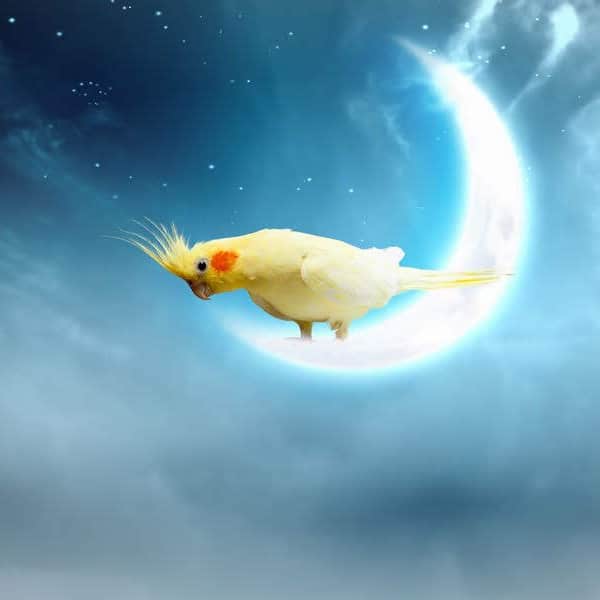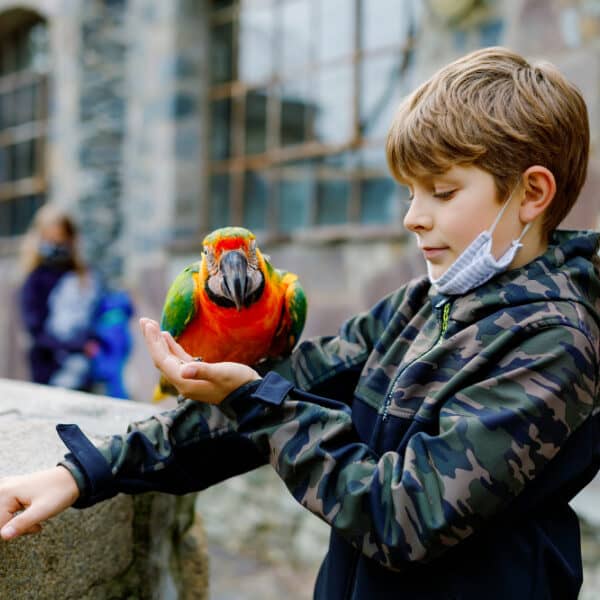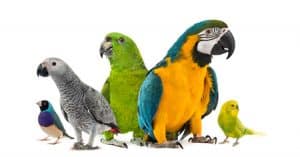
How Long Should It Take for a Cockatiel to Grow Back Clipped Wing Feathers?
Last Updated on by Mitch Rezman
How long should it take for a Cockatiel to grow back clipped wing feathers?
I have a 7-month-old cockatiel, he’s super happy all the time and is “shedding” his down feathers constantly lately. The people we bought him from at about 2 to 3 months old were clipping his wings and he still hasn’t been able to fly properly. We keep him clean, happy, and healthy.
My answer
For the record, we are proponents of keeping birds flighted. But if a person loses a bird because it is flighted and they walked outside with the bird on their shoulder un-tethered – they are a dumbass.
I will address other flight safety issues in the home momentarily but let’s talk about your particular issue which is not simply about the length of your bird’s wing feathers.
Cockatiel feathers can grow back rapidly, usually, within three to six months after a clip, they have the ability to fly.
The bigger problem you are having is that the bird never learned to fly after having fledged.
In other words referring to a young bird, having wing feathers that are grown enough for flight makes a bird “fledged”. Your bird doesn’t know how to fly in spite of being a bird – clearly a case of human intervention.
As ironic as it sounds the first thing we want to do is give your bird flying lessons. We need to instill confidence in your bird and teach your cockatiel where the “landing zones” are in your home are so the bird knows where it’s going to land regardless of the room. This avoids “panic” landings and wall crashes.
Lesson one will be getting the bird to fly about 1 foot away from the cage learning to land on top of the cage or on top of a cage top-mounted perch. We have two Booda Comfy rope perch installed as an upside-down “U” atop our Cockatiel’s birdcage.

It is an easy place to land coming from any area in the home. This is important so the bird learns not to land on the front of the birdcage chest first, possibly injuring itself. Day one and two you will work about 1 foot away from the cage.
Then each day back off another foot or two until the bird confidently knows how to fly and more importantly where and how to land on top of the cage safely. Each safe landing should be rewarded with a high-value treat and a click from a training clicker if you have one.
Editor’s note: As humans, we take a bird’s ability to fly and land for granted. Both are complex activities
One of the objections I hear from many captive bird owners is “I don’t want my bird to fly into a wall”.
The reason that happens is that once again the birds have had no flight training.
They take off then panic and start flying erratically rather than thinking and having a “flight plan”.
To those who challenge me on this, I’ll ask them to remember the first time they got behind the wheel of an automobile and recall how well that went for them.
Your bird is processing thought 3 times faster than humans and they will learn to fly with agility much quicker than it took you to learn how to negotiate an entrance ramp on your first merge onto the expressway driving lesson.
A Better Bird Ep 13 How Bird Proof Is Your Home ~ Video
Let’s inject another safety tip here. The room cannot have a lot of large mirrors or exposed windows.
They need to be filtered or blocked with either shades, shutters, blinds or you can introduce floral arrangements, dream catchers, stained glass pieces or even decals to cover big picture windows.
Birds do not understand the concept of glass nor mirrors and we don’t want them flying into either while they are learning to fly and the layout of your home.
Also, look around and check for furnishings or other objects that can harm a bird-like the sharp edge of a glass coffee table. Household items like scissors, tape, or a hobby knife lying around can mean catastrophe.
To avoid birds escaping out of open doors you have to follow a couple of simple rules.
- Know where your flighted bird is at all times so that should the doorbell ring you know that the bird is safely in its cage or in another room.
- The inner door has to close before the outer door opens.
For example, we have vestibules in the front and the back of our home meaning that there is both an inner door and an outer door. You can create a simple vestibule with curtains in front of an entry door which will also help save energy and reduce drafts.
Once the bird is comfortable flying to the cage it’s time to teach him or her about landing zones throughout the house. Landing zones can be the top of a closet door or a shower rod in the bathroom. Every room the bird is allowed should have some sort of playstand.
For almost 4 years, when I awoke I would open up our cockatiels cage door. Every morning for the hour or so that I took to tidy myself and the apartment Popcorn would follow me around our 62 foot long home and land in the same place in every room.

At least once a day she would do figure eights at probably about 15 miles an hour throughout the living room and dining room two or three times and then confidently land on the soft perch atop her birdcage.
Editors note: In terms of a flighted versus a nonflighted bird in the home, a flighted bird is a happier, healthier, and more confident bird. More floor walking birds are stepped on because they can’t get out of the way fast enough, thus losing their life than escaping from an open exterior door.
Speaking of which you will learn to walk backward through open doors you plan to close so you don’t slam the door on the bird or crush them as they flip sideways trying to fly through the remaining open space, as the door closes.
A flighted bird will exhibit far fewer hormonal issues because of the calorie burn.
If you have other animals in the house flight allows the bird to escape from them. Because birds exhibit a fight or flight mentality you are less likely to get bitten by a bird that knows it can easily fly away rather than being stuck in a potentially bad hand-ling situation.
If you are cooking, a flighted or clipped bird has no place in the kitchen. Kitchens are the only room in the house where open flames and sharp objects are encouraged. It’s no place for a bird. Birds do not understand the meaning of flames or heat like boiling water.
Things can go sideways pretty quickly with a bird that gets inquisitive and wants to know what you are cooking, while you look away for a moment. I often hear “my birds are always supervised so there’s no chance of an accident,” says the user of a smartphone not seeing the blur of feathers going from 0 to 30 MPH in 2 feet.
We bring these feathered angels into our homes, clip their wings, and expose them to erratic light cycles. We ask them to eat totally un-intuitive food like pellets from overflowing food dishes and then wonder where we failed. Birds have evolved over 50 million years with the expectation and the ability to fly. There is not a rational reason to clip their wings.
That said if you insist on clipping your bird’s wings, at least learn how to do it especially with the big birds you just can’t lop off a dozen flight feathers.
Also, remember just because a bird has been clipped does not mean it can’t fly. Your wide-bodied birds like Lovebirds and Amazons can still manage to fly at low heights even with very short wings.
The next time you want to show off your bird with clipped wings by walking outside on a breezy day keep in mind that birds are built for flight and can be lifted by the wind then (not) found two counties over in the blink of an eye – you’ve been warned.
Written by Mitch Rezman
Approved by Catherine Tobsing
Your Zygodactyl Footnote
Author Profile
Latest entries
 The Traveling BirdJune 26, 2025Can You Name 5 Parrot Species That Are Living Wild in the USA?
The Traveling BirdJune 26, 2025Can You Name 5 Parrot Species That Are Living Wild in the USA? Bird BehaviorJune 26, 2025How is it Parrots Are Problem Solvers Social Animals and Even Use Tools?
Bird BehaviorJune 26, 2025How is it Parrots Are Problem Solvers Social Animals and Even Use Tools? Bird & Parrot AnatomyJune 25, 2025How a Tiny Chemical Modification Makes Parrots Nature’s Living Paintings
Bird & Parrot AnatomyJune 25, 2025How a Tiny Chemical Modification Makes Parrots Nature’s Living Paintings PigeonsJune 20, 2025How Do Parrots Thrive in Cities Outside Their Native Habitats?
PigeonsJune 20, 2025How Do Parrots Thrive in Cities Outside Their Native Habitats?
This Post Has 2 Comments
Leave a Reply
You must be logged in to post a comment.



NMA
5 Apr 2018I see that this post is a year old. I have the same question and now I am a little ticked off. I bought my baby ‘tiel very recently and he’s about 10 weeks old.. I didn’t think to tell the breeder not to clip his wings, which I believe she did. because he wants to fly but he can’t. So I guess now I have to also train him to fly… good grief!
WindyCityParrot
5 Apr 2018Hi NMA – cockatiels fledge at 3 -5 weeks but we don;t know if the breeder allowed the bird to fly – unlikely but it would be good information.
Cockatiel wings grow back rapidly (90 days) but it should be easy enough to hold out a wing – you’ll know because if only 4 or 5 wing feathers are long – the rest short – the wings are clipped – which is actually in your favor
You don;t have to teach your teil to fly Mother Nature took care of that – you have to teach the bird how to land. more here-> https://goo.gl/r4bbDG